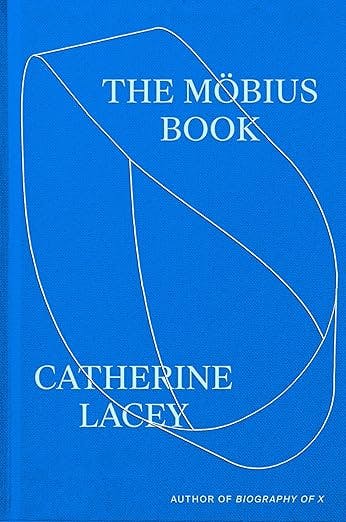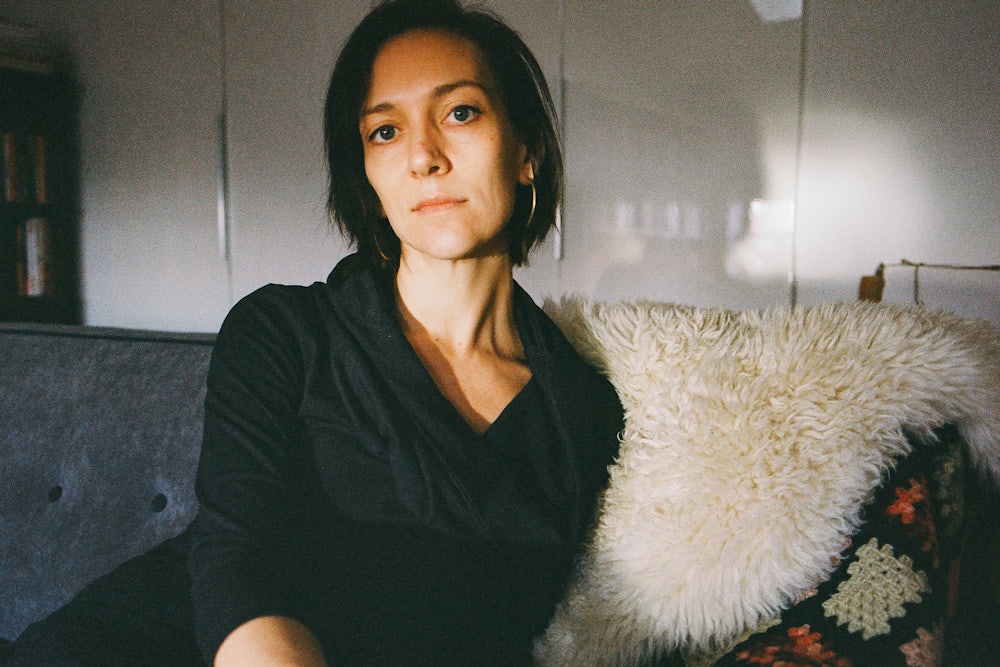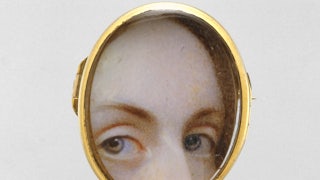Catherine Lacey’s fourth novel, Biography of X, which came out in 2023, is one of the most formally and intellectually interesting books of the decade so far. It’s an audacious, compelling collage of truth and invention, a story of a made-up artist that draws on bits of real artists’ lives in a biographic sense and repurposes them to fictional ends. It’s good enough to read over and over, searching for the line where reality crosses into imagination. When I learned that Lacey’s follow-up, The Möbius Book, would be a hybrid, genre-blurring text without a beginning or an end, my immediate thought was that maybe she had gotten herself on, or at least near, the level of Julio Cortázar’s canonic experimental novel Hopscotch, which can be read with its chapters in one of two suggested sequences or in any other order the reader likes.
Unfortunately, The Möbius Book isn’t anything like that. It’s hybrid only in the sense that the first part of the book is invented and the second is true, with the former starting inside the front cover and printed right-side up and the latter starting inside the back cover and printed upside down. The experience of twisting the book around to keep reading does, for a moment, make it resemble a Möbius strip, but The Möbius Book isn’t endless. It doesn’t even end without resolution. It’s just half a weak novel and half a weak memoir, stuck together as if one might improve the other.
The Möbius Book begins with an unmistakable beginning: “Edie’s on the line, says she’s coming over, says it’s urgent, no context.” In a sentence, Lacey at once creates mystery—who is Edie, and what’s going on that’s so urgent?—and promises to resolve it, which she does, more swiftly than she might have in a full-length novel. Edie is the protagonist’s best friend, and what’s urgent is that the protagonist, recently divorced from her wife and estranged from their twins, is alone on Christmas. Edie too is freshly single, having just left an emotionally abusive boyfriend, but she’s enjoying the change much more than the protagonist, whose name is Marie, or at least sleeping with a lot more people. Everyone says you’re having a crisis, Marie tells her (the dialogue in The Möbius Book is in italics, not quotation marks); no, Edie replies, actually everyone says that you’re the one having a crisis; and then they hug, Marie thinking, “This is why people know each other.”

If all this sounds corny, that’s because it is, and consciously so. Cliché is one of Lacey’s central concerns in the novel half of The Möbius Book. She writes explicitly about them and lines up an array, ranging from the sad Christmas to Marie’s thoughts about “song lyrics [that] have a way of seeming true” to a canned #MeToo story about Edie’s former boyfriend having a relationship with one of his art-school students, which was really about power, and he should have known that. But awareness of cliché isn’t the same as commentary on it. For the entirety of The Möbius Book’s novel half, Edie and Marie sit in Marie’s apartment, discussing faith and relationships and whether the dark liquid they saw seeping from beneath the neighbors’ door is blood, but neither their conversation nor Marie’s inner monologue ever breaks through cliché to the accuracy—emotional or descriptive—that would be its antidote.
Much of the issue here is that Lacey sketches her characters too vaguely for either of them to say something precise. At times, it’s hard to tell Edie’s and Marie’s dialogue apart, or even to remember which is which. Lacey’s prose in the novel half of The Möbius Book is vague as well. It has one great line—Marie, a former smoker, used to catch herself “inhaling from a cigarette she had no memory of lighting, like there was a ghost inside of her that smoked without her awareness”—but nowhere else does the language so vividly capture experience. In fact, it can seem as if Lacey wants to avoid doing so. Edie’s ex uses stock phrases as a tool of manipulation, a manifestation of cliché’s enduring capacity to seduce, but otherwise, he derives power, we’re told, from his “ongoing attempt to never resemble, however briefly, anyone else.” Lacey rejects this effort far more successfully than she manages to reject the tropes she tries to undermine.
The Möbius Book’s memoir half goes some way toward explaining why Edie’s bad former partner resembles Lacey’s bad former partner, whom she calls The Reason, though a quick google tells you he’s the novelist Jesse Ball. Memoirs and autobiographical novels about authors breaking up with other authors are common enough to be a cliché of their own, one Lacey may be aspiring to avoid through The Möbius Book’s genre split. She does not, however, attempt to call attention to or undermine the tropes of contemporary memoir. Indeed, she deploys one of the most conventional. She flicks between tales from her breakup and reflections on her fervent adolescent religiosity and its abrupt end, using one story to illuminate the other. This technique is called braiding, and, since the celebrated memoirist Vivian Gornick used it in Fierce Attachments, her 1987 account of her relationship with her mother, it has gradually become such a popular mode as to be yet another cliché.
At their best, braided memoirs allow an individual story to exceed the bounds of its author’s life, often by setting it in a familial or historical context that not only explains the writer’s tale but is enriched by the personal illustration. Very few writers get there, though. The form has a significant pitfall, which The Möbius Book’s other weaknesses reflect: It’s extremely challenging to give a subject the kind of sustained consideration that reveals surprises and takes the reader into new territory when the topic in question only gets half the writer’s attention. In many braided memoirs, this means that the more personal story becomes emotionally dominant, relegating the book’s more expansive concerns to the background. To a degree, the same is true in the memoir half of The Möbius Book, which considers Christianity as a wobbly analogue to romance. Another problem, though, is that in the novel half of the text, Lacey hardly writes about religion at all, which is to say it gets only a quarter of her attention in the book as a whole. To come to an interesting conclusion about a such a large—and extensively written-about—topic with so little time would have been a true feat, but Lacey doesn’t attain it. In her book’s memoir section, the word faith crops up frequently during passages dealing with love—as in: “I had loved The Reason with a faith I knew to be profound”—but the connection doesn’t go much beyond that.
Lacey’s stories of her time with The Reason are the book’s strongest, since they are viscerally upsetting. They are also the only ones in the book that aren’t vague. He is emotionally abusive, a gaslighter who threatens her with violence and, when she objects, accuses her of “trying to paint him as a villain, as a kind of man he obviously was not.” After a passage on the eating disorder that followed her loss of religion, Lacey describes an episode in which she gained a few pounds and The Reason bullied her into dieting, “suggest[ing] a new schedule for when and what I should eat” and then telling her it was “female and embarrassing” for her to get upset. She obeyed him, and looking back, sees having done so as the moment “I must have first and most deeply conceded to the idea that The Reason had the power to tell me, at all times, in all ways, who I was.”
All of this is, of course, wrenching to read. It is impossible not to empathize with Lacey or to be relieved that The Reason broke up with her—insisting, as he did, that it was because she had stopped loving him. But the memoir’s ability to elicit these reactions doesn’t make it good literature. It seems designed to illuminate the fiction that came before it, perhaps by speaking more deeply about love and its relationship to our beliefs and our pasts, but it does not do so. Maybe it would if it were longer, or if it took on less subject matter or fewer themes, or if it were a traditional memoir instead of a would-be Möbius strip. As it is, though, the book feels, more than anything else, like two incomplete drafts. Still, just as it begins with a beginning, it ends with an unmistakable ending: Lacey meeting her now-husband, the writer Daniel Saldaña París, and falling in love. Of course, this is also a beginning of its own, but it lands like a trope far older—and often more satisfying—than a braided memoir: a Happily Ever After.






